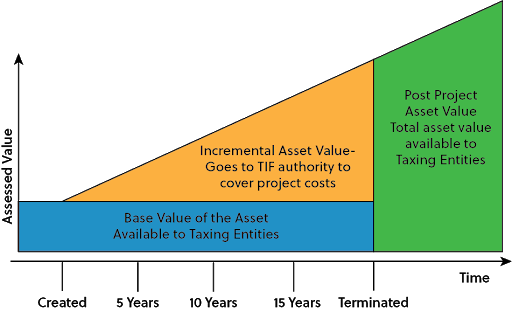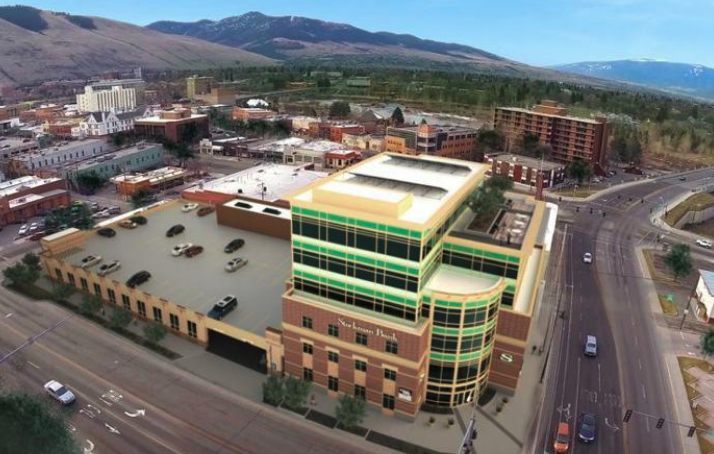You’ve probably heard the term “TIF” in the news, usually related to new projects in a sometimes rundown part of town. Generally, TIF (Tax Increment Financing) funds are supposed to boost economic development. Many cities across Montana have TIF districts, including Missoula, Bozeman, Helena, and Kalispell. Though complex, TIF can be a useful lever for cities to pull as they work towards revitalizing their landscapes. But, keep in mind that the rules and regulations governing TIF funding vary widely by city and state. What’s true for one city might not be the case elsewhere.
What is TIF? Tax Increment Funding (TIF) is intended to encourage development in areas of a city considered “blighted” or at risk of blight. Simply put, blight means an area in failing condition. Think boarded up, graffitied buildings, traffic bottlenecks, and abandoned lots.
Where do TIF funds come from? In a TIF district, the base value of all taxable property within the district is frozen for a period of years. The tax revenue from this frozen, base value is distributed to all jurisdictions that levy mills in the district.
As rehabilitation occurs in the district and new projects spring up, property values may increase. If values increase, tax revenue above the frozen base is directed back into the area as TIF funds.
It’s important to note that money spent in a TIF district is generated from within the district- taxes from other sources across town can’t be used to fund TIF projects.
What’s the point of TIF? TIF funding can attract projects that may not pencil out otherwise due to site prep and infrastructure costs.
In shorthand, this is known as “but for.” As in, the project wouldn’t be possible “but for” the TIF funds.
Where does TIF exist? In Montana, TIF funding is available in Urban Renewal Districts (URDs). In Missoula, there are six renewal districts.
(TIF funding can also be used in Targeted Economic Development Districts (TEDD), areas that are infrastructure deficient. This post focuses on URDs, with TEDDs covered in a follow up).
Who manages TIF funding? In Montana, state law allows for an urban renewal agency to manage TIF funding. These agencies can operate through a five-member board or as a department inside of the local governing body. The Missoula Redevelopment Agency (MRA) fills the role in Missoula, with a five-member board.
What does an URD look like? The Riverfront Triangle URD, established in 2008, covers West Broadway from Russell to Orange Street. The City of Missoula identified vacant, deteriorating buildings, inefficient streets, outmoded sidewalks and undeveloped land as blighted conditions in this URD. You can learn more about active development in the area here.
How are TIF funds used in URDs? In the Riverfront Triangle URD, $1.5 million in TIF funds went to development for Stockman Bank. Total project costs were $30 million.
Funds were used to tear down the existing (and dilapidated) building on the corner of Broadway and Orange Streets, as well as burying utilities, improving sidewalks and adding street lighting.
That being said, TIF funds can be used in a variety of ways. Each city uses these funds with the ultimate goal of economic development for the public good, with some latitude in how the money is applied.
TIF Pros: Proponents point to economic development that can occur in an area that might otherwise fall into even greater disrepair- leading to crime, poor community health, and mounting long-term expenses for a city.
TIF Cons: Opponents argue that some TIF projects are feasible without using subsidies. Because of the location of TIF projects, gentrification is an issue. That can lead to increased public scrutiny, often slowing the development process. Finally, some critics point out that every dollar going to new development is a dollar that doesn’t support local services like schools, fire or police.
So what? TIF districts present new opportunities for community development. Ultimately, URDs and TIFs can create a more functional real estate market for growth, which is critical to economic development.
Want to learn more about real estate opportunities in Montana’s Urban Renewal Districts? Contact Matt Mellott with Sterling CRE Advisors.





